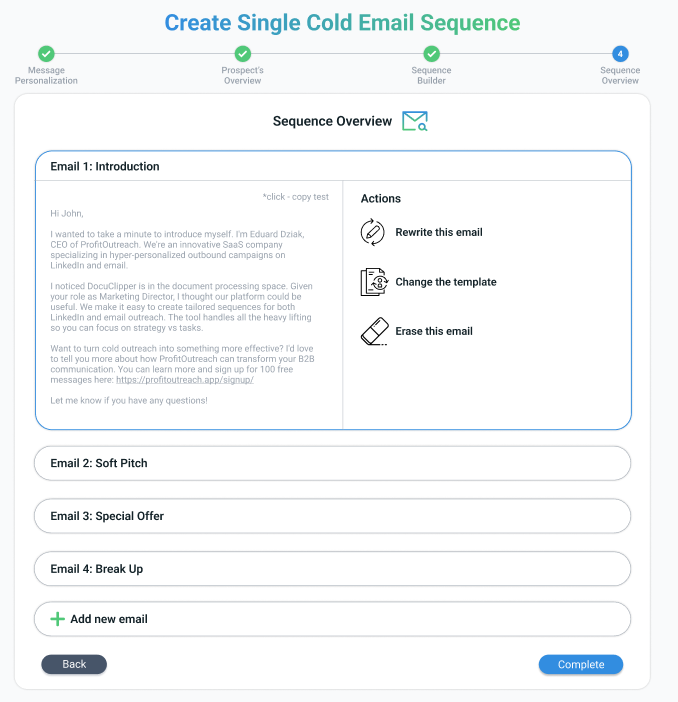If you want to be successful with cold email marketing, you need to learn how to write effective cold email sequences in order to feed relevant information to your prospects without overloading them with information.
And that’s why a cold email sequence is important as it allows you to provide all the information your prospects need to decide without stuffing everything in one email.
In this article, I am going to teach you how you can craft the perfect cold email sequence for any situation.
What is a Cold Email Sequence?
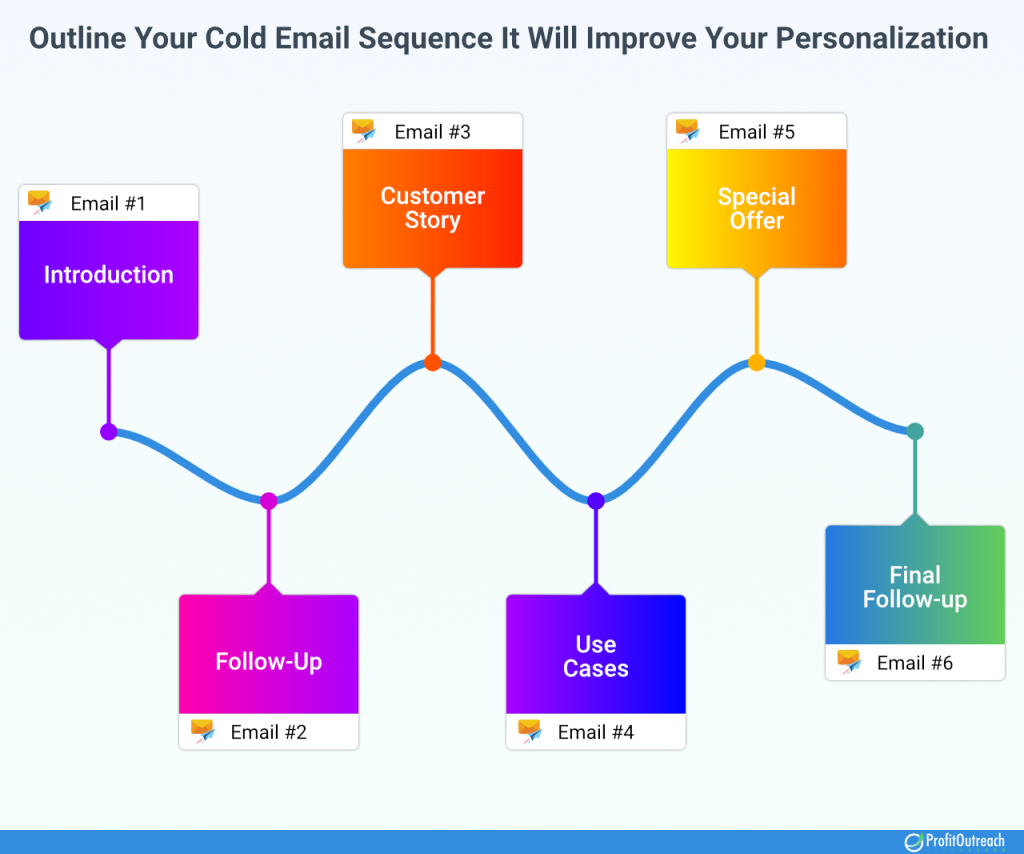
A cold email sequence is a series of cold emails sent to potential prospects who haven’t interacted with your business before.
Unlike single cold emails, a sequence allows you to gradually introduce your value proposition, build rapport, and provide the necessary information for your prospects to make informed decisions.
By strategically spacing out the emails, you avoid overwhelming your recipients while maintaining consistent communication.
This approach increases the likelihood of capturing their interest and ultimately converting them into customers.
Understanding and implementing an effective cold email sequence is crucial for successful email marketing campaigns.
Why Cold Email Sequence Is Important?
Cold email sequences are essential because they significantly boost your response and conversion rates.
When you send multiple attempts and contact multiple prospects, you can increase your cold email response rates by as much as 160%.
Each follow-up email adds value, with the first and second follow-ups increasing your chances of getting a reply by 21% and 25%, respectively.
Persistence is key in cold email marketing.
Studies show that sending up to 8 follow-up emails can double or even triple your conversion rates.
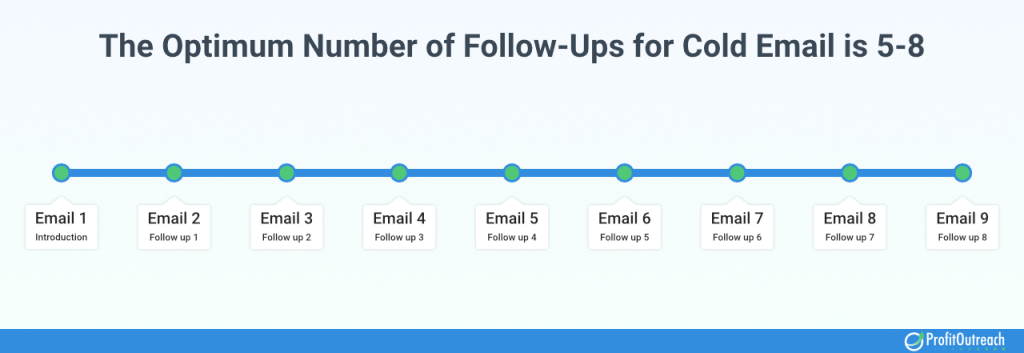
This persistence reflects the Pareto principle in sales, where 20% of sales reps are responsible for 80% of the sales, largely due to their consistent follow-up efforts.
Don’t give up too soon. Half of all sales occur after the fifth contact, yet most sales reps abandon their efforts after just two attempts.
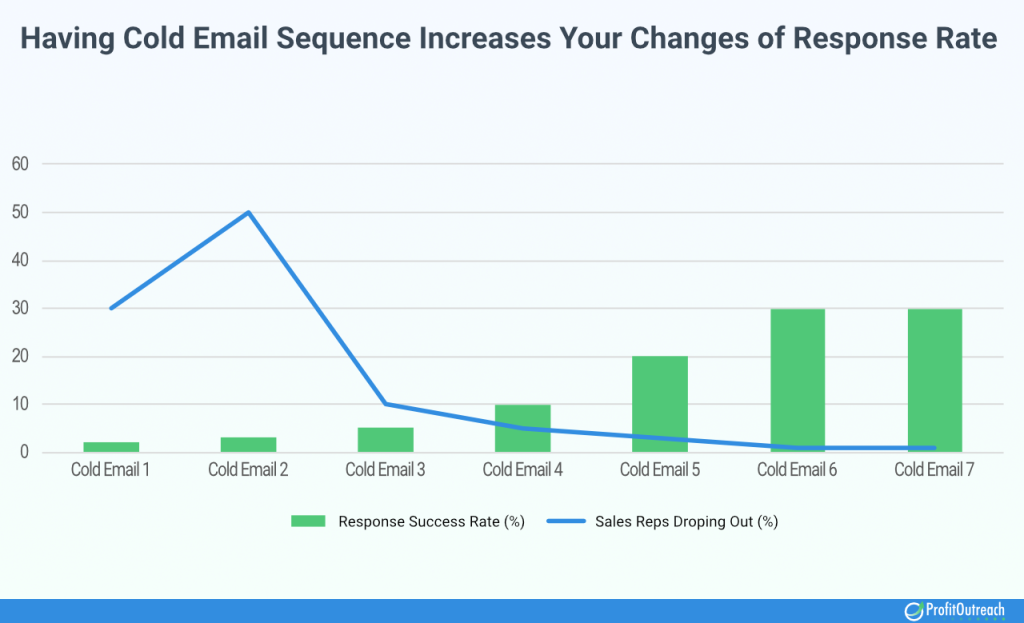
This demonstrates the importance of persistence and the effectiveness of follow-ups. In fact, 55% of replies to cold email campaigns come from follow-up emails.
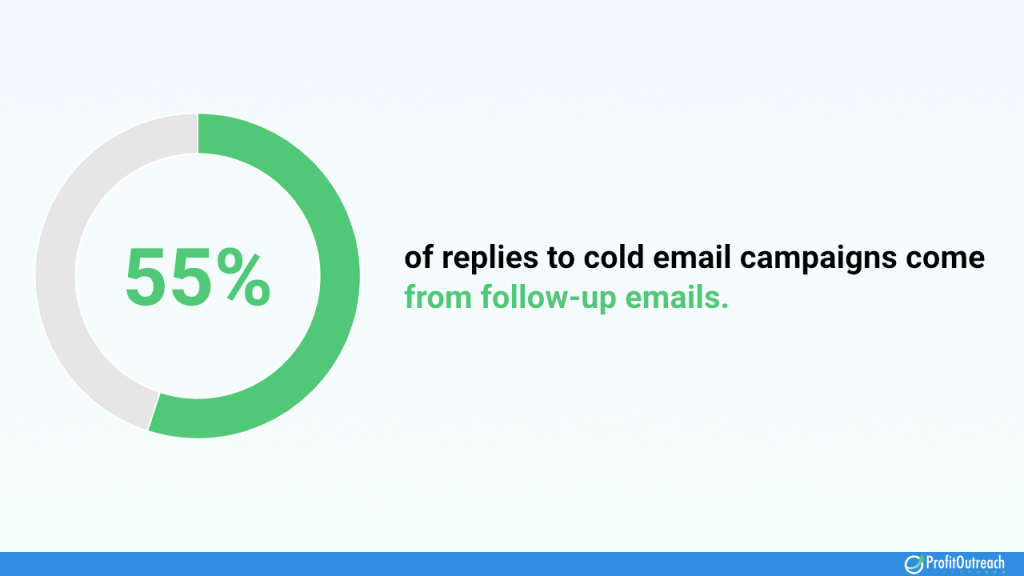
Therefore, by crafting a well-structured cold email sequence, you maintain communication with your prospects, provide them with additional value, and increase your chances of converting them into customers.
Remember, consistent follow-up is not just about being persistent but also about showing your prospects that your solution can be really useful to your prospects in solving their pain points.
(Learn more about cold email statistics)
How to Write Cold Email Sequence in 6 Steps
By following my structured guide on how to write cold email sequences you will be able to craft high-converting cold email sequences for any situation.
So here is my step-by-step process on how to write a cold email sequence:
Step 1: Determine Target Audience
Every cold email sequence should be crafted for a very specific target audience.
For instance, at ProfitOutreach, we target sales and marketing leaders, each with unique pain points and reasons for needing cold email generation software.
Naturally, this means creating different sequences for each audience segment.
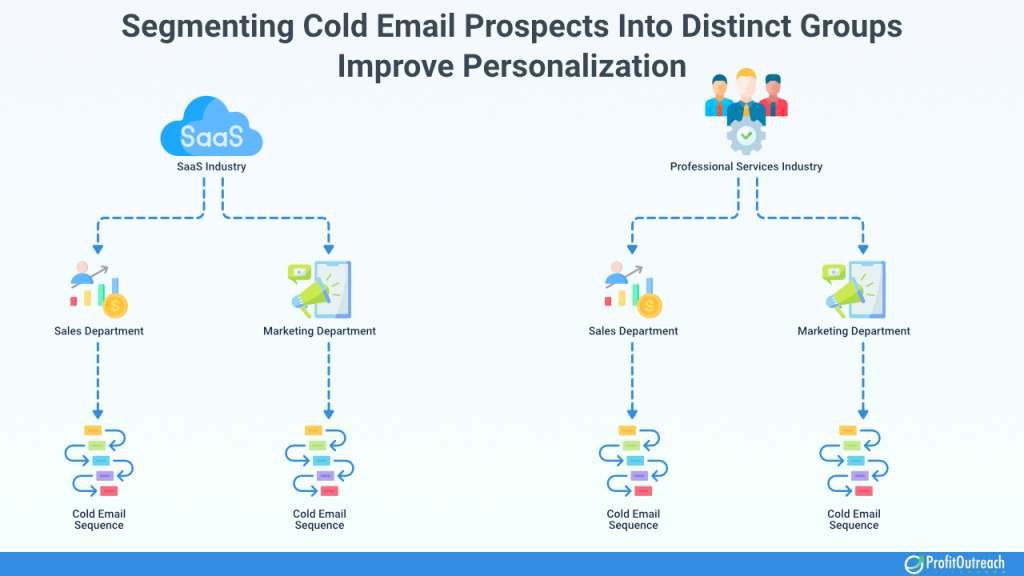
That’s to start crafting effective cold email sequences, you need to determine your target audience.
Understanding their specific needs and challenges allows you to tailor your messages to resonate with them.
TIP: Begin with at least two target audiences. This approach lets you test and compare performance, helping you identify which audience brings in more revenue. By refining your focus and tailoring your sequences, you can enhance your engagement and conversion rates.
Step 2: Understand the Essential Cold Email Templates
The next step is to understand the cold email templates you can use to build your sequence.
I like to think of a cold email sequence like a Lego set, and the templates are the individual pieces.
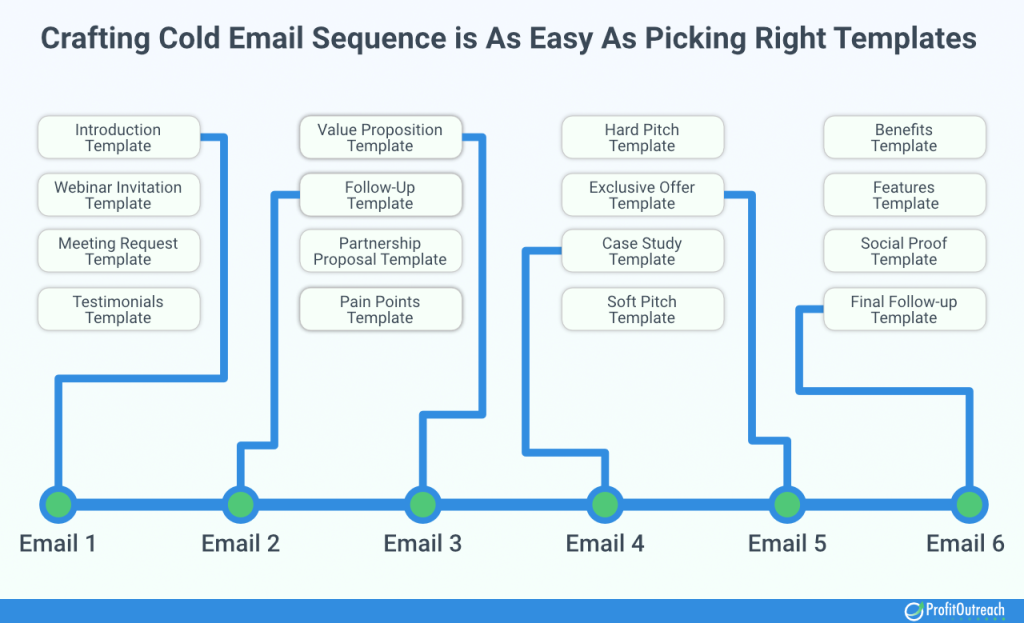
By using different cold email templates, you can create various sequences that align with your goals and objectives.
Each template serves a unique purpose, whether it’s introducing yourself, following up, sharing a testimonial, or making a final call-to-action.
So familiarize yourself with these templates to see how they can fit together to form a cohesive and effective email sequence.
I recommend checking out our cold email template library for inspiration.
This resource will give you ideas on what cold email templates you can use to build up your cold email sequence.
BTW the ProfitOutreach cold email sequence generator has plenty of cold email templates you can choose from and we even write your entire hyper-personalized cold email sequence.
Step 3: Select Cold Email Templates That’ll Make Up Your Sequence
Now that you understand the different cold email templates available, it’s time to select the templates that will make up your cold email sequence.
Each cold email sequence has standardized cold email templates:
- Beginning: This typically is your introduction cold email template where you introduce yourself, your company, your solution, and your value proposition.
- Follow-ups: This can be any cold email template that you believe could be informationally beneficial to your prospect such as a case study, follow-up value proposition, testimonial, use cases, benefits, etc. It doesn’t mean it has to be a follow-up cold email template, as any subsequential cold email is a follow-up.
- Ending: This is your final follow-up cold email template where you take one last shot to persuade your prospect to reply to you, sign up, or take any other desired action.
So, begin by identifying the key information you want to present to your prospect and based on that select the relevant cold email templates.
A good rule of thumb is: One key information, one cold email.
For example:
- Sharing your testimonials is one key piece of information, thus, one cold email.
- Talking about the use cases of your solution is one key piece of information, thus, one cold email.
- Sharing your value proposition is one key piece of information, thus, one cold email.
You get the idea.
So, choose templates that best fit each stage and align with your objectives.
For example, start with an introduction template to make a strong first impression, followed by a follow-up template to maintain engagement, and then share your testimonials, after that, you can share the benefits of your solution or service, and lastly, a final call-to-action template to close the deal. Here you have a nice 5 cold email sequence.
Make sure each selected template addresses the specific needs and pain points of your target audience.
Combining these templates strategically will help you create a seamless and effective cold email sequence.
Utilize our cold email template library for additional inspiration and to ensure you’re selecting the most effective templates for your campaign.
Step 4: Gather Available Information
With your templates selected, it’s time to gather the information you need to personalize and enhance each email.
The content should be directly related to the templates you’ve chosen.
For instance, if you’re using a testimonials template, collect compelling testimonials from satisfied customers. If you’ve selected a pain points template, research and list the common pain points of your target audience.
For a case study template, ensure you have detailed case studies that showcase your product or service’s success.
Having this relevant information at hand will make your cold emails more credible and persuasive as well as it will be much easier to write cold emails.
Step 5: Start Writing Each Individual Cold Email
The next step is to start writing each individual cold email.
Here is where you show off your cold email copywriting skills.
Now, writing cold emails depends solely on what templates you selected so I cannot give you specific advice on how and what to write.
But I can provide you with cold email best practices when it comes to writing cold emails. So here they’re:
- Keep each cold email within 90-150 words.
- Ensure each cold email has opening text, body text, and CTA. (Visit best cold email CTA tips)
- Keep your subject line around 5-8 words max. (Visit best cold email subject line tips)
- Always tailor the content to the specific target audience. Visualize you’re talking to them. It helps me a lot.
- Keep the cold emails as personalized as possible based on your prospect’s details.
- Clearly state the value or benefit the recipient will gain from your product or service.
- Use professional language and avoid words or phrases that might trigger spam filters.
- Ensure your emails are free of typos and grammatical errors. Professionalism is key in maintaining credibility.
- Always ensure you run A/B testing for your cold emails, subject lines, CTAs, etc.
Step 6: Experiment, Test, Change
The final step is to experiment, test, and change your cold email sequence. This is crucial for optimizing your results.
You can start by A/B testing different subject lines, email content, and CTAs to see which versions perform best.
Track key metrics such as cold email open rates, response rates, and conversion rates to gather data on your cold emails’ effectiveness.
Don’t be afraid to tweak your approach based on the feedback and data you receive.
Adjust your messaging, timing, and personalization to improve your results continually.
Remember, what works for one audience might not work for another, so be flexible and ready to adapt.
Also, your first results won’t be the best and by continuously testing your approach you will be able to improve your cold email results.
5 Cold Email Sequence Examples for Different Situations
In this section, I am going to share with you the common cold email sequences our customers us for inspiration:
1. Cold Email Sequence for Promoting SaaS Business
Sequence overview:
- Email 1: Introduction Template
- Email 2: Follow-up Template
- Email 3: Case Study Template
- Email 4: Features Template
- Email 5: Final Follow-Up Template
This sequence is designed to gradually introduce your SaaS product, showcase its benefits, and build credibility through social proof and case studies.
You start with an introductory email to make a strong first impression. The follow-up email reminds your prospect of the value your product offers.
The case study email provides tangible proof of your product’s effectiveness, while the benefits email highlights specific advantages.
The final follow-up email encourages a response, ensuring your prospect has multiple touchpoints to consider your product.
This structured approach increases the chances of engaging and converting your prospects.
Learn more about SaaS cold email sequence.
2. Cold Email Sequence for Promoting Products
Sequence overview:
- Email 1: Introduction Template
- Email 2: Benefits Template
- Email 3: Reviews Template
- Email 4: Use Cases Template
- Email 5: Final Follow-Up Template
This sequence is tailored to effectively promote your product.
You begin with an introduction email to capture attention.
The second email highlights the key benefits of your product, showing how it can solve your prospect’s problems.
The reviews email adds social proof, showcasing positive feedback from satisfied customers.
The use cases email demonstrates practical applications of your product, making it more relatable.
Finally, the follow-up email prompts the prospect to take action, ensuring they have all the information needed to make a decision.
This comprehensive approach helps in engaging your audience and driving conversions.
Learn more about product cold email sequence.
3. Cold Email Sequence for Webinar Promotion
Sequence overview:
- Email 1: Webinar Invitation Template
- Email 2: Follow-up Template
- Email 3: Educational Content Template
- Email 4: Reminder Template
- Email 5: Final Follow-Up Template
This sequence is designed to effectively promote your webinar. You start with a webinar invitation to generate interest and encourage sign-ups.
The follow-up email serves as a reminder and emphasizes the value of attending.
The educational content email provides additional value related to the webinar topic, building credibility and anticipation.
The reminder email ensures your prospects remember the date and time of the webinar.
The final follow-up email serves as a last-minute nudge to join, increasing the likelihood of attendance.
This structured approach helps maximize webinar registrations and participation.
Learn more about webinar promotion cold email sequence.
4. Cold Email Sequence for Promoting Services
Sequence overview:
- Email 1: Introduction Template
- Email 2: Pain Points Template
- Email 3: Testimonial Template
- Email 4: Objections Template
- Email 5: Final Follow-Up Template
This sequence is crafted to effectively promote your services.
You begin with an introduction email to establish initial contact.
The second email addresses the specific pain points your prospects face, showing how your services can solve their problems.
The testimonial email adds credibility by sharing positive experiences from satisfied clients.
The partnership email emphasizes the long-term value and benefits of working with your company.
The final follow-up email encourages a response, ensuring your prospects have all the information they need to consider your services.
This comprehensive approach helps engage your audience and drive conversions.
Learn more about service promotion cold email sequence
5. Cold Email Sequence for Promoting Special Offer
Sequence overview:
- Email 1: Introduction Template
- Email 2: Exclusive Offer Template
- Email 3: Benefits Template
- Email 4: Urgency Template
- Email 5: Final Follow-Up Template
This sequence is designed to effectively promote a special offer.
You start with an introduction email to inform your prospects about the offer. The second email provides details about the exclusive offer, highlighting its unique value.
The benefits email outlines the specific advantages and savings your prospects will gain.
The urgency email creates a sense of urgency, encouraging prompt action by emphasizing limited availability or a deadline.
The final follow-up email serves as a last reminder to take advantage of the offer, increasing the likelihood of conversion.
This structured approach helps to attract interest, create urgency, and drive immediate responses to your special offer.
Learn more about the special offer cold email sequence.
6. Cold Email Sequence for Partnerships Outreach
Sequence overview:
- Email 1: Introduction Template
- Email 2: Value Proposition Template
- Email 3: Use Cases Template
- Email 4: Social Proof Template
- Email 5: Final Follow-Up Template
This sequence is tailored to effectively reach out for partnerships.
You begin with an introduction email to make initial contact and establish interest.
The second email presents a compelling value proposition, explaining the mutual benefits of the partnership.
The use cases email demonstrates successful examples of similar partnerships, making your proposal more tangible and attractive.
The social proof email adds credibility by showcasing endorsements or successes from existing partners.
The final follow-up email encourages a response and finalizes the outreach, ensuring your prospect has all the information needed to consider the partnership.
This approach helps in building strong, mutually beneficial partnerships through clear and persuasive communication.
Learn more about partnership outreach cold email sequence.
8 Most Common Cold Email Templates
Here I am going to share with you some most common cold email templates used by our customers.
Remind you, our cold email templates don’t like this and they’re crafted based on yours and prospect information.
These are just templates. (Reason why we created ProfitOutreach.)
1. Introduction Cold Email Template
Subject: [First Name], Improve Your Business Potential with [Your Company]
Hi [First Name],
I hope this email finds you well. I’m [Your Name] from [Your Company]. We specialize in helping businesses like yours achieve [specific benefit]. With our [product/service], you can [mention key feature or advantage].
We’ve helped companies such as [Client 1] and [Client 2] see significant improvements in [specific metric or outcome].
I’d love to discuss how we can support your goals and drive growth for [Prospect’s Company]. Are you available for a quick call next week? Please let me know a time that works for you.
Looking forward to your response.
Best regards,
[Your Name]
[Your Position]
[Your Contact Information]
Description: The introduction cold email template is your first point of contact with a prospect. It aims to capture their attention and introduce your company and the value you offer. Keep it concise, personalize it with the prospect’s name and company, and highlight a specific benefit to spark their interest and encourage further engagement.
Learn more about the introduction cold email template.
2. Follow-up Cold Email Template
Subject: Just Following Up, [First Name]!
Hi [First Name],
I hope you’re doing well. I wanted to follow up on my previous email regarding how [Your Company] can help [Prospect’s Company] achieve [specific benefit].
Our [product/service] has a proven track record of delivering [specific results], and I believe it can be a great fit for your needs.
If you have any questions or need more information, please don’t hesitate to reach out. I’d be happy to schedule a quick call to discuss how we can assist you.
Looking forward to your response.
Best regards,
[Your Name]
[Your Position]
[Your Contact Information]
Description: This follow-up cold email template is designed to gently remind your prospect about your previous email while providing additional value. It’s concise and to the point, emphasizing the benefits of your product or service and offering to address any questions they might have. By suggesting a call, you create an opportunity for direct engagement, increasing the likelihood of a response.
Learn more about the follow-up cold email template.
3. Testimonial Cold Email Template
Subject: [First Name], See How [Client’s Company] Achieved [Specific Result] with [Your Company]
Hi [First Name],
I hope this email finds you well. I wanted to share a success story from one of our clients, [Client’s Company]. They faced similar challenges as you and achieved [specific result] using our [product/service]. Here’s what they had to say:
“[Testimonial Quote]” – [Client’s Name], [Client’s Position]
This testimonial highlights the impact our solution can have. At [Your Company], we strive to help businesses like yours achieve exceptional results. I believe we can achieve similar success for [Prospect’s Company].
Are you available for a quick call next week to discuss how we can help you reach your goals? Please let me know a time that works best for you, and I will make sure to accommodate you.
Looking forward to your response.
Best regards,
[Your Name]
[Your Position]
[Your Contact Information]
Description: Use this template to share a client’s success story, showcasing the impact and benefits of your product/service through a compelling testimonial.
Learn more about the testimonial cold email template.
4. Case Study Cold Email Template
Subject: [First Name], See the Impact of [Your Company] Through Our Latest Case Study
Hi [First Name],
I hope you’re doing well. I wanted to share an insightful case study about how [Client’s Company] overcame [specific challenge] and achieved [specific result] with our [product/service].
[Brief Summary of Case Study: Challenge, Solution, Result]
You can read the full case study here: [Link to Case Study]
This case study demonstrates the effectiveness of our solution in real-world scenarios, and I believe we can replicate similar success for [Prospect’s Company].
Are you available for a quick call next week to discuss how we can help you achieve your goals? Please let me know a time that works best for you.
Best regards,
[Your Name]
[Your Position]
[Your Contact Information]
Learn more about the case study cold email template.
Description: Use this template to showcase the success of your product or service through real-world examples, providing credibility and compelling evidence to engage your prospects.
5. Final Follow-up Cold Email
Subject: [First Name], Last Chance to Connect with [Your Company]
Hi [First Name],
I hope you’re doing well. I wanted to reach out one last time regarding how [Your Company] can help [Prospect’s Company] achieve [specific benefit]. Our [product/service] has a proven track record of delivering results, and I’d hate for you to miss out.
If you’re interested, I’d love to schedule a quick call to discuss how we can support your goals. Please let me know a time that works best for you.
Looking forward to your response.
Best regards,
[Your Name]
[Your Position]
[Your Contact Information]
Description: This final follow-up email template is your last attempt to engage the prospect, emphasizing the benefits and urging them to take action before it’s too late.
Learn more about the final follow-up cold email template.
6. Webinar Invitation Cold Email Template
Subject: Join Us for an Exclusive Webinar on [Webinar Topic]
Hi [First Name],
I hope you’re well. I’m excited to invite you to our upcoming webinar on [Webinar Topic]. In this session, we will cover [key points or benefits of the webinar].
Date: [Webinar Date]
Time: [Webinar Time]
Registration Link: [Link to Webinar Registration]
Don’t miss this opportunity to gain valuable insights and connect with industry experts. Reserve your spot today!
Looking forward to seeing you there.
Best regards,
[Your Name]
[Your Position]
[Your Contact Information]
Description: This template is used to invite prospects to a webinar, highlighting the key points and benefits, and encouraging them to register.
Learn more about the webinar invitation cold email template.
7. Value Proposition Cold Email Template
Subject: [First Name], Unlock [Specific Benefit] with [Your Company]
Hi [First Name],
I hope this email finds you well. At [Your Company], we specialize in helping businesses like yours achieve [specific benefit]. Our [product/service] offers [key features or advantages] that can help you overcome [specific challenge] and improve [specific metric or outcome].
I’d love to discuss how our solution can bring value to [Prospect’s Company]. Are you available for a quick call next week?
Looking forward to your response.
Best regards,
[Your Name]
[Your Position]
[Your Contact Information]
Description: This template focuses on clearly presenting your value proposition, highlighting the specific benefits and key features of your product or service to address the prospect’s needs and challenges.
Learn more about the value proposition cold email template.
8. Benefits Cold Email Template
Subject: [First Name], Discover the Benefits of [Your Product/Service]
Hi [First Name],
I hope you’re doing well. I wanted to share how [Your Product/Service] can help [Prospect’s Company] achieve [specific benefit]. Our solution offers the following key advantages:
- [Benefit 1] – [Brief description of Benefit 1]
- [Benefit 2] – [Brief description of Benefit 2]
- [Benefit 3] – [Brief description of Benefit 3]
These benefits can significantly improve [specific aspect of their business], helping you achieve [specific outcome].
I’d love to discuss how we can support your goals. Are you available for a quick call next week?
Best regards,
[Your Name]
[Your Position]
[Your Contact Information]
Description: This template highlights the key benefits of your product or service, detailing how each advantage can address the prospect’s specific needs and improve their business outcomes.
Learn more about the benefits cold email template.
How Many Cold Emails Are in a Cold Email Sequence?
A typical cold email sequence consists of 4-7 emails.
Each cold email in the sequence is crafted to build on the previous message, gradually providing more information and increasing the chances of engagement by educating your prospects.
The longer the sequence, the higher the likelihood of receiving a response or conversion.
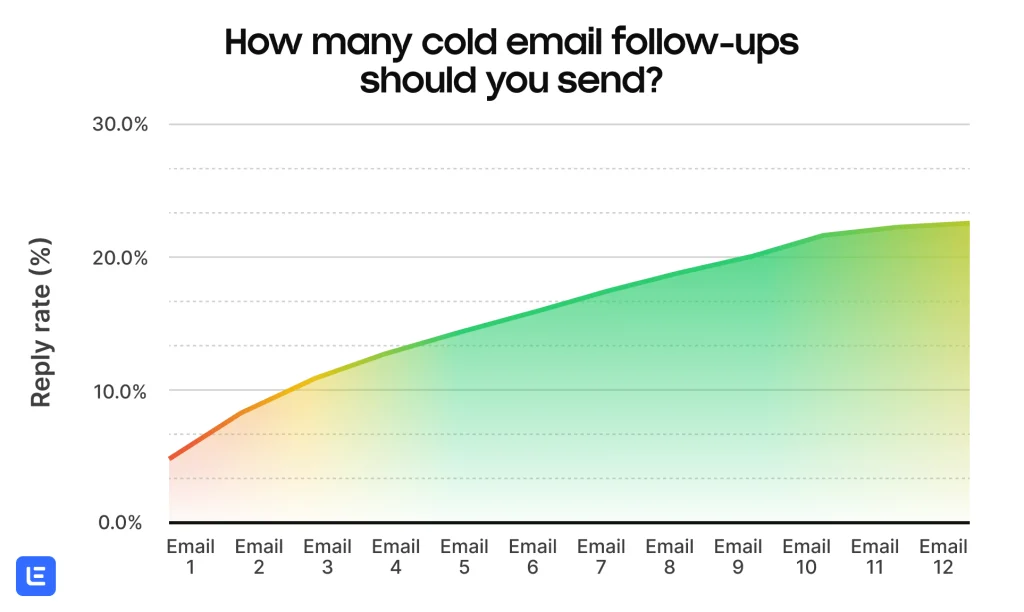
(Source)
This approach allows you to maintain consistent communication with your prospects without overwhelming them with too much information at once. (I know I already said it, but did you read the whole article though?)
By strategically spacing out your emails, you can remind your prospects of your value proposition and address their pain points over time.
Plus, it’s very hard to catch your prospect in good time, meaning, they have time and mood (very important) to read your cold email with an open mind.
That’s why persistence often pays off, as many responses come from follow-up emails rather than initial contact.
Automate Writing Cold Email Sequences with ProfitOutreach
ProfitOutreach is an intelligent AI-powered cold email sequence generator that crafts hyper-personalized cold email sequences based on your offer information, your information, and your prospects’ information.
Crafting cold email sequences for one or thousands of prospects is as easy as selecting the cold email templates you like and that’s it.
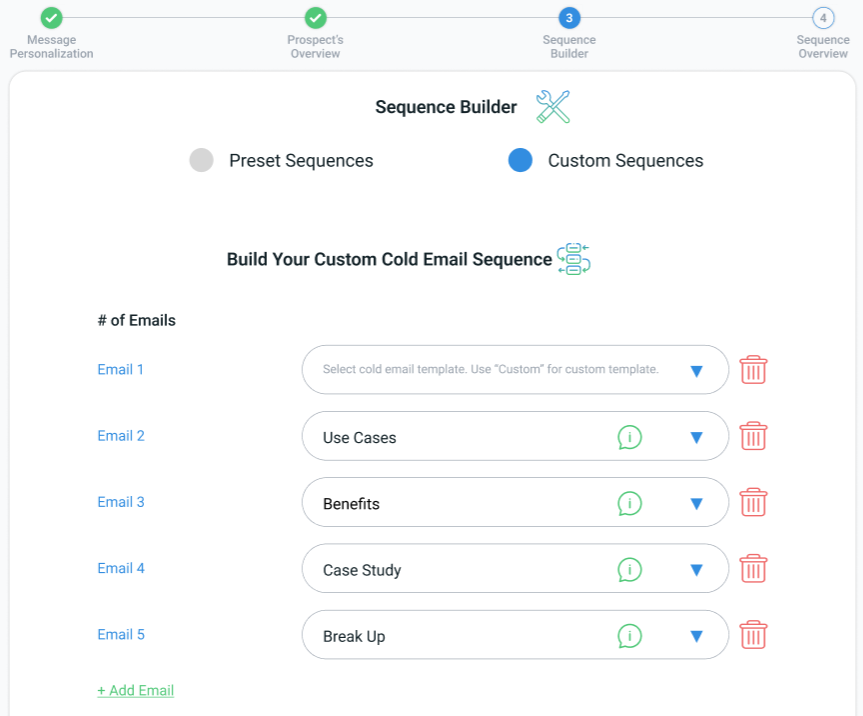
Our software will provide unique cold emails in every sequence unlike using “customized” cold email templates increasing your engagement & significantly reducing chances of landing in promotional or spam folders!
Boost your outreach profit with ProfitOutreach!
FAQs about Cold Email Sequences
In this section you’re going to learn about commonly asked questions about cold email sequences:
What is the best cold email sequence?
The best cold email sequence typically includes 4-7 emails: an introduction, follow-up, value proposition, testimonial or case study, benefits, and a final follow-up. This structure gradually builds rapport, provides value, and increases the chances of a response or conversion by addressing the prospect’s needs and pain points over multiple touchpoints. However, be mindful that it really depends on case by case.
Why is important to have more follow-ups in cold emails?
Having more follow-ups in cold emails is crucial because it significantly increases response rates. Persistence helps remind prospects of your value proposition, addresses their concerns, and demonstrates your commitment. Many responses come from follow-up emails rather than the initial contact, making follow-ups essential for higher conversion rates and successful cold email campaigns.
How do you structure a cold email?
A cold email should have a clear structure: a compelling subject line, a personalized greeting, a brief introduction, a value proposition, a clear call-to-action (CTA), and a polite closing. Keep it concise, relevant, and focused on the prospect’s needs.
How many cold emails are too many?
Sending more than 12+ cold emails can be considered excessive and may annoy the prospect. It’s important to find a balance between persistence and respect for the recipient’s time and interest.
Can I follow up with prospects after a longer pause?
Yes, you can follow up with prospects after a longer pause. We usually recommend after 6 months you can put the prospect back into your sequence. Ensure your follow-up is relevant, acknowledges the time gap, and provides new value or information to re-engage their interest.

